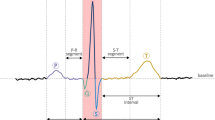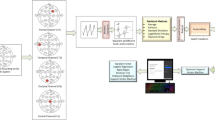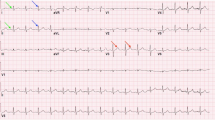Abstract
The early detection of heart abnormalities through electrocardiography (ECG) is essential for reducing the prevalence of cardiac arrest worldwide. Often, subjects are unaware of the condition of their hearts until detected at the last stage. In this study, various records in real-time and PhysioNet databases were examined using chaos analysis. Chaos analysis was implemented by plotting different attractors against various time-delay dimensions. The main advantages of chaos analysis approach include: (1) a preprocessing stage is not demanded to the recorded ECG signal, and (2) it helps to estimate the reliable and robust thresholds for QRS detection using time-delay dimension (embedding), correlation dimension, Lyapunov exponent, and entropy. ECG may be a useful candidate to classify heart diseases; however, visualization through ECG may not be sufficient because of the minute differences that exist in the ECG recordings. Therefore, the effective automatic detection of ECG signals is essential. Further, ECG datasets should be analyzed using time–frequency representations for getting frequency contents of the signal at each time point. ECG signals are nonstationary in nature; the assumption of stationarity is valid on a short-time basis. For this purpose, a short-time spectrum is computed using the short-time Fourier transform (STFT) as a feature extraction tool in this paper. Noise and baseline wander are filtered before the STFT operation to ensure correct frequency components of the QRS complex. For filtering, a digital band-pass filter has been used since its filtering characteristics are invariant with drift and temperature. The automatic detection of QRS complex has been proposed which is useful in early diagnosis of cardiac diseases. The essential feature of detection stage is to build feature selection approach for having a minimal feature set which includes ample information about data for the planned application. In this paper, the QRS complex is detected by applying principal component analysis (PCA) on the fused results of individual features extracted using chaos analysis and STFT. Using PCA, the estimated principal components show the degree of morphological beat-to-beat variability. The detection performance is evaluated in terms of sensitivity (Se), positive predictivity (PP), detection error rate (DER), and accuracy (Acc). The proposed technique yields encouraging performance parameter values such as 99.93% Se, 99.97% PP, 0.0895% DER, and 99.91% Acc in the analysis of data from the PhysioNet database and 99.93% Se, 99.96% PP, 0.097% DER, and 99.90% Acc in the analysis of data from the real-time database. Suitable comparisons have been presented with the existing techniques.




Similar content being viewed by others
References
V. Gupta, M. Mittal, KNN and PCA classifier with autoregressive modelling during different ECG signal interpretation. J. Proc. Comput. Sci. 125, 18–24 (2018)
V. Gupta, M. Mittal, in Respiratory Signal Analysis using PCA, FFT and ARTFA. 2016 International Conference on Electrical Power and Energy Systems (ICEPES-16) (Maulana Azad National Institute of Technology, Bhopal, India, 2016), pp. 221–225
V. Gupta, M. Mittal, Electrocardiogram signals interpretation using Chaos theory. J. Adv. Res. Dyn. Control Syst. 10(2), 2392–2397 (2018)
V. Gupta, M. Mittal, in Dimension Reduction and Classification in ECG Signal Interpretation Using FA & PCA: A Comparison. International Conference (M3HPCST-2018) (IPEC Ghaziabad, India, 2018) pp. 7–14
https://www.betterhealth.vic.gov.au/health/conditionsandtreatments/ecg-test. Accessed 17 Jan 2018
V. Viknesh, P. Ram Prashanth, Matlab implementation of ECG signal processing. IOSR J. VLSI Signal Proc. 3(1), 40–47 (2013)
J. Kranjec, Non-contact heart rate and heart rate variability measurements: a review. Elsevier. J. Bio. Sig. Proc. Conf. 13, 102–112 (2014)
A.P.M. Gorgels, Electrocardiographyy. J. Cardiol. Med. 8, 8–9 (2007). https://doi.org/10.1007/978-1-84628-715-2_3
B.J. Drew, R.M. Califf, M. Funk, E.S. Kaufman, M.W. Krucoff, M.M. Laks, P.W. Macfarlane, C. Sommargren, S. Swiryn, G.F. Van Hare, Practice standards for electrocardiographic monitoring in hospital settings: an American heart association statement from the councils on cardiovascular nursing, clinical cardiology, and cardiovascular disease in the young: endorsed by the interna-tional society of computerized electrocardiology and the American Association of Critical-Care Nurses. Circulation 110(17), 2721–2746 (2004)
Y. Kaya, H. Pehlivan, Feature selection using genetic algorithms for premature ventricular contraction classification, in 2015 9th IEEE International Conference (2015), pp. 1229–1232
I. Kaur, R. Rajni, A. Marwaha, ECG signal analysis and arrhythmia detection using wavelet transform. J. Inst. Eng. India Ser. B 97(4), 499–507 (2016)
J.P. Madeiro, P.C. Cortez, F.I. Oliveira, R.S. Siqueira, A new approach to QRS segmentation based on wavelet bases and threshold technique. Med. Eng. Phys. 29, 26–37 (2007)
N.V. Thakor, J.G. Webster, W.J. Thompkins, Estimation of QRS complex power spectra for design of a QRS filter. IEEE Trans. Biomed. Eng. 31(11), 702–705 (1984)
Z. Zidelmal, A. Amirou, M. Adnane, A. Belouchrani, QRS detection based on wavelet coefficients. J. Comput. Methods Progr. Biom. 107(3), 490–496 (2012)
E.D. Übeyli, ECG beats classification using multiclass support vector machines with error correcting output codes. J. Dig. Signal Proc. 17(3), 675–684 (2007)
R.B. Govindan, K. Narayanan, M.S. Gopinathan, On the evidence of deterministic chaos in ECG: surrogate and predictability Analysis. J. Chaos 8(2), 495–502 (1998)
M. Casdagli, Chaos and deterministic versus stochastic nonlinear modeling. J. R. Stat. Soc. Ser B Methodol. 159(2), 1–23 (1991)
S. Sahoo, P. Biswal, T. Das, S. Sabut, De-noising of ECG signal and QRS detection using Hilbert transform and adaptive thresholding. Proc. Technol. 25, 68–75 (2016)
I. Saini, QRS detection using K-nearest neighbor algorithm (KNN) and evaluation on standard ECG databases. J. Adv. Res. 4(4), 331–344 (2013)
M. Merino, I.M. Gómez, A.J. Molina, Envelopment filter and K-means for the detection of QRS waveforms in electrocardiogram. J. Med. Eng. Phys. 37(6), 605–609 (2015)
R.J. Martis, U.R. Acharya, K.M. Mandana, A.K. Ray, C. Chakraborty, Cardiac decision making using higher order spectra. J. Biomed. Signal Proc. Control 8(2), 193–203 (2013)
P. Kora, A. Annavarapu, P. Yadlapalli, K.S.R. Krishna, V. Somalaraju, ECG based atrial fibrillation detection using sequency ordered complex hadamard transform and hybrid firefly algorithm. J. Eng. Sci. Technol. 20(3), 1084–1091 (2017)
U.R. Acharya, O. Faust, N.A. Kadri, J.S. Suri, W. Yu, Automated identification of normal and diabetes heart rate signals using nonlinear measures. J. Comput. Biol. Med. 43(10), 1523–1529 (2013)
B.S. Shaik, G.V.S.S.K.R. Naganjaneyulu, T. Chandrasheker, A.V. Narasimhadhan, A method for QRS delineation based on STFT using adaptive threshold. Proc. Comput. Sci. 54, 646–653 (2015)
Y. Li, Heartbeat Detection, Classification and Coupling Analysis using Electrocardiography Data. Thesis, Doctor of Philosophy, Case Western Reserve University, 2014. https://etd.ohiolink.edu/!etd.send_file?accession=case1405084050&disposition=inline. Accessed 15 Dec 2018
A.K. Dohare, V. Kumar, R. Kumar, An efficient new method for the detection of QRS in electrocardiogram. J. Comput. Electr. Eng. 40(5), 1–14 (2013)
J. Pan, W.J. Tompkins, A real time QRS detection algorithm. IEEE Trans. Biomed. Eng. 32(3), 230–236 (1985)
Physionet database/MIT-BIH Arrhythmia database. Accessed 17 Mar 2017
https://www.rohde-schwarz.com/in/applications/capturing-small-ecg-signals-in-medical-applications-application-card_56279-152385.html. Accessed 17 Nov 2017
C.H. Skiadas, C. Skiadas, Handbook of Applications of Chaos Theory, 1st edn. (CRC Press, Boca Raton, 2016), pp. 377–395
C. Wen, ECG Beat Classification Using GreyART Network, 1st edn. (IET Signal Process, Boca Raton, 2007), pp. 19–28
J.C. Sprott, Strange attractors: creating patterns in Chaos. Am. J. Phys. (2000). https://doi.org/10.1119/1.17885
D.T. Kaplan, L. Glass, Direct test for determinism in a time series. Phys. Rev. Lett. 68(4), 427–430 (1992)
F. Takens, Lectures Notes in Mathematics: Detecting Strange Attractor in Turbulence, in Dynamical Systems of Turbulence, ed.by D.A. Rand, B. S. Young, vol. 898 (Springer, Berlin, 1981), pp. 366–381
R.J. Martis, U.R. Acharya, C.M. Lim, J.S. Suri, Characterization of ECG beats from cardiac arrhythmia using discrete cosine transform in PCA framework. J. Knowl. Based Syst. 45, 76–82 (2013)
R.J. Martis, U.R. Acharya, K.M. Mandana, A.K. Ray, C. Chakraborty, Application of principal component analysis to ECG signals for automated diagnosis of cardiac health. J. Expert Syst. Appl. 39(14), 11792–11800 (2012)
R. Rodríguez, A. Mexicano, J. Bila, S. Cervantes, R. Ponce, Feature extraction of electrocardiogram signals by applying adaptive threshold and principal component analysis. J. Appl. Res. Technol. 13(2), 261–269 (2015)
V. Gupta, G. Singh, M. Mittal, S.K. Pahuja, Fourier Transform of Untransformable Signals Using Pattern Recognition Technique, in Proceedings of the Second International Conference on Advances in Computing, Control and Telecommunication Technologies (ACT’10) (IEEE Computer Society, Washington, DC, 2010), pp. 6–9
M.P.S. Chawla, PCA and ICA processing methods for removal of artifacts and noise in electrocardiograms: a survey and comparison. J. Appl. Soft Comput. 11(2), 2216–2226 (2011)
R.J. Martis, U.R. Acharya, H. Adeli, Current methods in electrocardiogram characterization. Comput. Biol. Med. 48, 133–149 (2014)
Author information
Authors and Affiliations
Corresponding author
Additional information
Publisher's Note
Springer Nature remains neutral with regard to jurisdictional claims in published maps and institutional affiliations.
Rights and permissions
About this article
Cite this article
Gupta, V., Mittal, M. QRS Complex Detection Using STFT, Chaos Analysis, and PCA in Standard and Real-Time ECG Databases. J. Inst. Eng. India Ser. B 100, 489–497 (2019). https://doi.org/10.1007/s40031-019-00398-9
Received:
Accepted:
Published:
Issue Date:
DOI: https://doi.org/10.1007/s40031-019-00398-9




